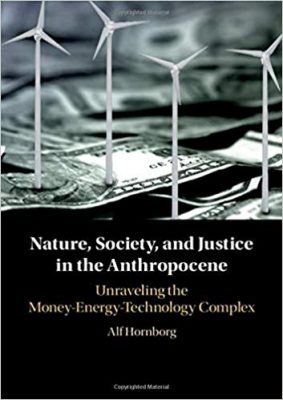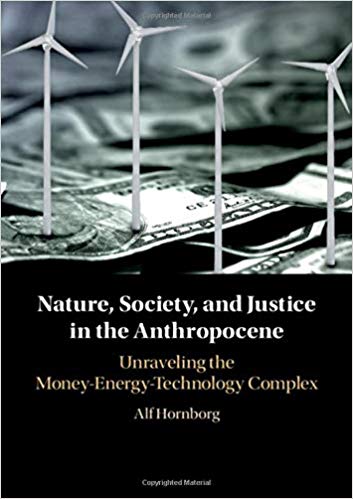 (This book is part of the series entitled New Directions in Sustainability and Society).
(This book is part of the series entitled New Directions in Sustainability and Society).
Author: Alf Hornborg
Publisher: Cambridge University Press – 288 pages
Book Review by: Sonu Chandiram
Many writers have described the period of time we are living in as ‘anthropocene’ – a period of severe global warming evidenced by extremes of weather in temperatures. We have for example, seen California fires caused by massive deforestation on the one hand, and hurricanes caused by the severely rising temperatures from the burning of fossil fuels and other human actions.
But as recently as in June 2019, the term ‘anthropocene’ has not even been recognized as a subdivision of geologic time period by two world bodies created to monitor the global environment: the International Commission on Stratigraphy (ICS) and the International Union of Geological Sciences (IUGS)
However, a small working group within a sub-commission of the ICS has taken some baby steps. This is what has happened, based on a review of articles on this topic on Wikipedia:
The Anthropocene Working Group (AWG) of the Sub-commission on Quaternary Stratigraphy (SQS) of the ICS voted in April 2016 to proceed towards a formal ‘golden spike’ (Global Boundary Stratotype Section and Point, or GSSP) proposal to define the anthropocene epoch in the geologic time scale, and presented the recommendation to the International Geological Congress in August 2016. In May 2019, the 34 member AWG voted in favor of making a formal proposal to the ICS.
A Wikipedia article simply entitled Anthropecene indicates several possible dates as being discussed as the beginning of such a geologic period to be given this term:
Various start dates for the Anthropocene have been proposed, corresponding with the Holocene calendar and ranging from the beginning of the Agricultural Revolution 12,000–15,000 years ago, to as recent as the 1960s.
As of June 2019, the ratification process continues and thus a date remains to be decided definitively, but the Trinity test of 1945 has been more favored than others. In May 2019, the AWG voted for a starting date in the mid 20th century, but the final decision will not be made before 2021.
The most recent period of the Anthropocene has been referred to by several authors as the Great Acceleration during which the socioeconomic and earth system trends are increasing dramatically, especially after the Second World War. For instance, the Geological Society termed the year 1945 as The Great Acceleration.[12]
What all this means essentially, is that once international organizations accept the scientific evidence that human actions are the cause of global warming, and formalize their acceptance of those causes, a clear action plan can be put forth to implement the agreed-upon solutions
In this very important and highly valuable book, the author Alf Hornborg provides fresh and unusual but workable solutions to the climate crisis we face, unlike others who have thrown their hands up in utter despair, whom he characterizes as “throwing the baby with the bath water.”
It is about nothing less than the survival of the human species on earth, and the entire animal and plant kingdom on planet Earth. Again, I assert that this is a must-read book. I especially urge you to first read chapter 11, Anthropocene Confusions: Dithering While the Planet Burns. We have listed the chapter titles below to provide you an overview of the contents of this important work.
Introduction
- Rethinking Economy and Technology
- The Anthropocene Challenge to our Worldview
- Producing and Obscuring Global Injustices
- The Money Game
- Anticipating Degrowth
- The Ontology of Technology
- Energy Technologies as Time-Space Appropriation
- Capitalism, Energy, and the Logic of Money
- Unequal Exchange and Economic Value
- Subjects Versus Objects: Artifacts Have Consequences, Not Agency
- Anthropocene Confusions: Dithering While the Planet Burns
- Animism, Relationism, and the Ontological Turn
- Conclusions and Possibilities
Afterword: Confronting Mainstream Notions of Progress
The last chapter Conclusions and Possibilities provides you important summaries and potential good, workable plans of action, but the Afterword is a gem that also must be read and re-read, because it provides you the important fresh perspective that is needed to understand the problem we face, and solve.
In the Afterword, Mr. Hornborg writes:
“Is the world heading for disaster, or getting better and better? Considering the many reasons we have to worry about the future of humanity and the biosphere (cf Latouche, 2009) a major puzzle for me is how so many people seriously seem to believe we can trust that technology and the market will solve problems of global justice and ecological sustainability.”
Author:
Alf Hornborg is an anthropologist and Professor of Human Ecology at Lund University in Sweden. He is the author of The Power of the Machine (2001), Global Ecology and Unequal Exchange (2011), and Global Magic (2016). He has conducted field research in Brazil, Canada and Peru.







